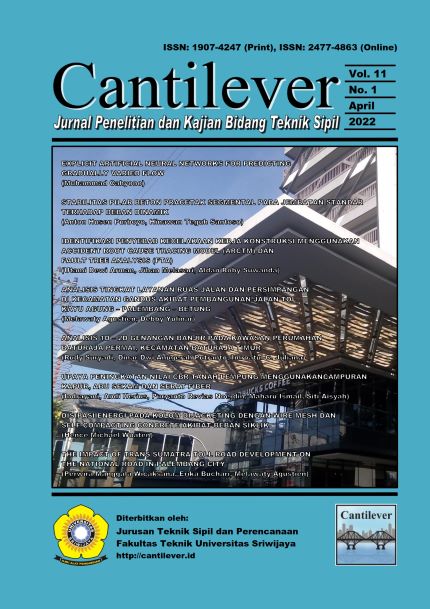Analisis 1D – 2D Genangan Banjir pada Kawasan Perumahan Baturaja Permai, Kecamatan Baturaja Timur 1D – 2D Flood Analysis in the Baturaja Permai Residential Area, East Baturaja District
Main Article Content
Abstract
Flooding is a problem that is often found in cities, especially in the rural areas of Baturaja Permai. When it rains, the quantity of river water exceeds its capacity or becomes too much, and there will be inundation caused by overflowing rivers. Factors of natural events such as high rainfall intensity cause flooding, coupled with factors from human activities. This study aims to investigate flood characteristics by developing an integrated model between hydrology and hydraulics. The development of this flood model is based on the hydrological model of runoff using the synthetic unit hydrograph method Soil Conservation Service (SCS), a one-dimensional (1D) hydraulic model for water flow propagation in macro drainage systems, and two dimensions (2D) for calculations if the river flow exceeds the existing capacity so that it experiences water propagation in the inundation area using the HEC-RAS software. To model the flood inundation it is required data Digital Elevation Model (DEM) was obtained by measuring the height of the land using a Total Station (TS) measuring instrument and analyzed using ArcMap software. The calculation of direct runoff is designed for a 5-year return period. The simulation results indicate that the Baturaja Permai area is an area that is prone to flooding with inundation depth of 0.558 m - 4.692 m and a peak runoff discharge of 15.6 m³/s at a 5-year return period.
Downloads
Article Details
Bambang, T. (2008). Hidrologi Terapan.Yogyakarta : Beta Offset
Bharath, A. et al. (2021) ‘Drainage morphometry based sub-watershed prioritization of Kalinadi basin using geospatial technology’, Environmental Challenges. Elsevier B.V., 5(June), p. 100277. doi: 10.1016/j.envc.2021.100277.
Dinar, P. D. A. et al. (2018) ‘Integration of surface water management in urban and regional spatial planning’, International Journal of GEOMATE, 14(45), pp. 28–34. doi: 10.21660/2018.45.18652.
Karamma, R. (2018) ‘Comparison of Model Hidrograf Synthetic Units ( HSS ) with the Model of Hidrograf Observations on DAS Jeneberang Gowa Regency , Indonesia’, 3(2).
Mai, D. T. and Smedt, F. De (2017) ‘A Combined Hydrological and Hydraulic Model for Flood Prediction in Vietnam Applied to the Huong River Basin as a Test Case Study’. doi: 10.3390/w9110879.
Putranto, Dinar Dwi Anugerah, Agus Yuono, M. E. (2020) ‘Analisis Profil Dasar Saluran Untuk Mengurangi Kecepatan Aliran Pada Pengalihan Sungai’, Cantilever, 4247(April). Available at: https://www.cantilever.id/index.php/cantilever/article/view/38/13.
Tamiru, H. and Wagari, M. (2021) ‘Machine-learning and HEC-RAS integrated models for flood inundation mapping in Baro River Basin, Ethiopia’, Modeling Earth Systems and Environment. Springer International Publishing, (0123456789). doi: 10.1007/s40808-021-01175-8.
Venkatcharyulu, S. and Viswanadh, G. K. (2021) ‘Runoff volume model for Godavari sub-basin using HEC-RAS software’, Modeling Earth Systems and Environment. doi: 10.1007/s40808-021-01311-4.

This work is licensed under a Creative Commons Attribution-NonCommercial 4.0 International License.
Authors who publish with this journal agree to the following terms:
- Authors retain copyright and grant the journal right of first publication with the work simultaneously licensed under a Creative Commons Attribution-NonCommercial 4.0 International License that allows others to share the work with an acknowledgment of the work's authorship and initial publication in this journal.
- Authors are able to enter into separate, additional contractual arrangements for the non-exclusive distribution of the journal's published version of the work (e.g., post it to an institutional repository or publish it in a book), with an acknowledgment of its initial publication in this journal.
- Authors are permitted and encouraged to post their work online (e.g., in institutional repositories or on their website) prior to and during the submission process, as it can lead to productive exchanges, as well as earlier and greater citation of published work (See The Effect of Open Access).
